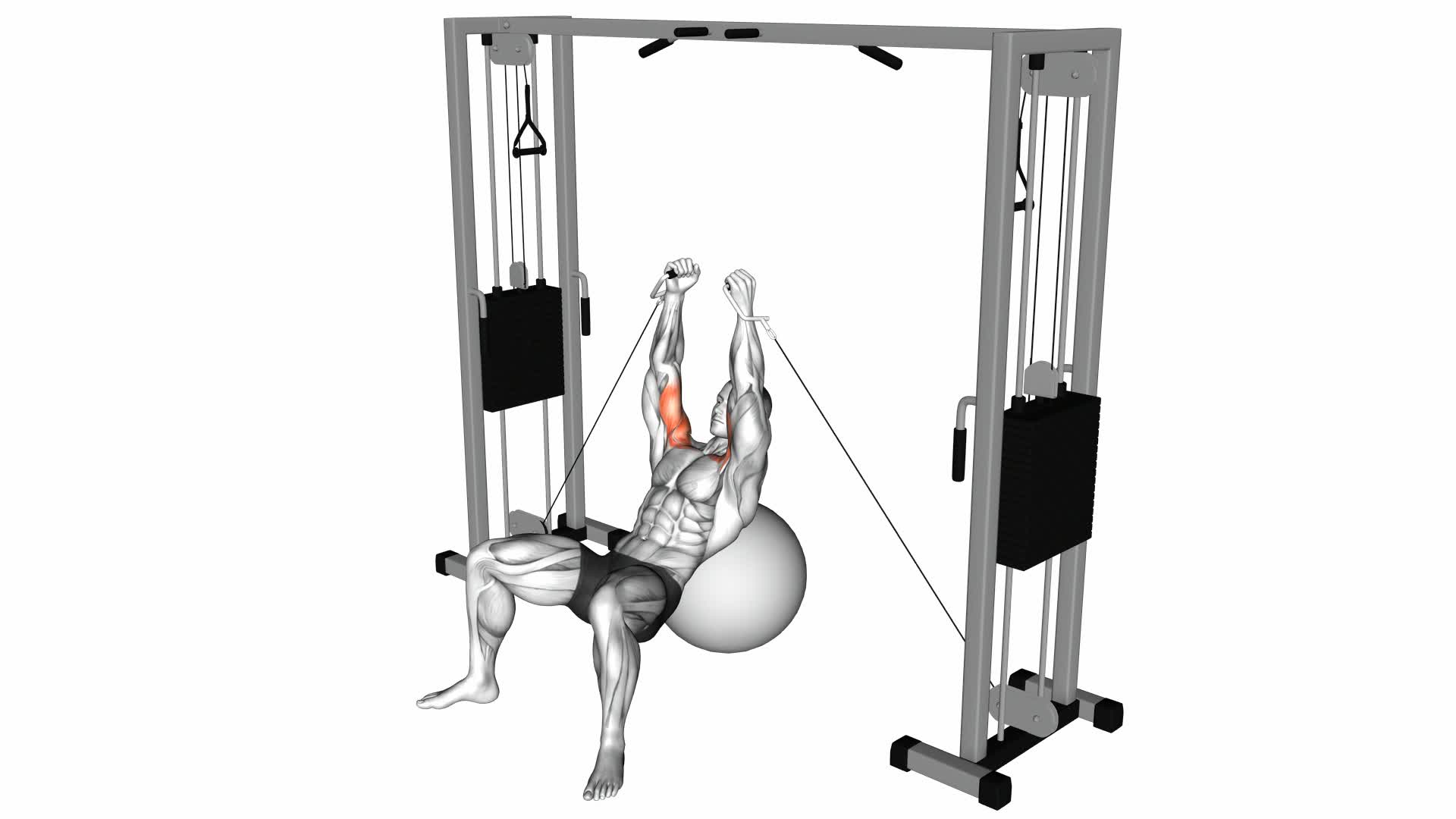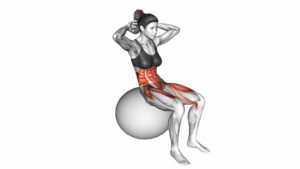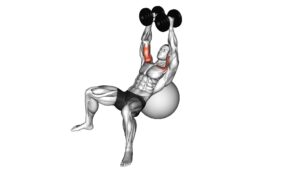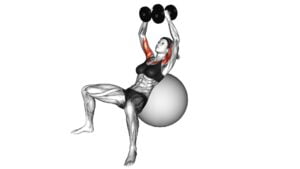Cable Incline Fly (On Stability Ball) – Video Exercise Guide & Tips

In this video guide, you'll learn how to perform the cable incline fly on a stability ball.
Watch This Exercise Video
This exercise offers a range of benefits, including targeting your chest muscles for increased strength and definition.
You'll discover the proper form and technique to maximize your results, as well as variations and modifications to suit your fitness level.
With these tips, you'll be on your way to a successful workout that will challenge and transform your upper body.
Let's get started!
Key Takeaways
- The Cable Incline Fly targets chest muscles and provides increased strength and definition.
- Proper form and technique are important for maximizing the effectiveness of the exercise and preventing injuries.
- Variations and modifications, such as using dumbbells or adjusting the bench incline, can provide different challenges and target different areas of the chest.
- Setting goals, incorporating warm-up exercises, paying attention to breathing techniques, and listening to your body are all important for a successful workout.
Benefits of the Cable Incline Fly
You'll experience increased chest muscle activation and improved upper body strength with the Cable Incline Fly exercise. The Cable Incline Fly primarily targets the muscles of the chest, particularly the pectoralis major and minor. By using a cable machine, you're able to apply tension to the chest muscles throughout the entire range of motion, leading to greater muscle activation compared to other chest exercises. This exercise also engages the anterior deltoids, triceps, and serratus anterior muscles to a lesser extent.
One of the key benefits of the Cable Incline Fly is its potential for progression and overload. As you become stronger, you can increase the weight or resistance on the cable machine, challenging your chest muscles even more. This progressive overload stimulates muscle growth and strength gains over time. Additionally, the cable machine allows for a greater range of motion compared to dumbbells, allowing you to stretch and contract your chest muscles fully.
To ensure proper form and technique, it's important to maintain a stable incline bench position and engage your core throughout the exercise. Keep a slight bend in your elbows and focus on squeezing your chest muscles as you bring your arms together in front of you. Avoid using excessive momentum or swinging movements, as this can decrease the effectiveness of the exercise.
With an understanding of the muscles targeted and the potential for progression and overload, let's move on to discussing the proper form and technique for the Cable Incline Fly exercise.
Proper Form and Technique
To ensure proper form and technique for the Cable Incline Fly exercise, it's important to consistently maintain a stable incline bench position and engage your core throughout the entire range of motion. This will help you maximize muscle activation and avoid common mistakes that could lead to injury or ineffective results.
One common mistake to watch out for is using too much weight. It's important to start with a weight that you can comfortably handle and gradually increase it as your strength improves. Using excessive weight can compromise your form and put unnecessary strain on your muscles and joints.
Another mistake to avoid is allowing your shoulders to hunch forward during the exercise. This can take the focus away from your chest muscles and place more stress on your shoulders and neck. To prevent this, consciously retract your scapulae and keep your shoulders pulled back throughout the movement.
Additionally, make sure to maintain a controlled and smooth motion throughout the exercise. Avoid swinging your arms or using momentum to lift the weights. This not only reduces the effectiveness of the exercise but also increases the risk of injury.
Equipment and Set-up
To properly set up for the Cable Incline Fly exercise on a stability ball, position yourself in front of the cable machine with the stability ball placed at the bottom of an incline bench. The stability ball is an essential piece of equipment for this exercise as it provides an unstable surface that engages your core muscles and challenges your balance.
Before starting the exercise, make sure the stability ball is properly inflated and positioned securely at the bottom of the incline bench. Place your feet shoulder-width apart on the ground, ensuring a stable base of support.
Next, grasp the handles of the cable machine with an overhand grip, making sure your hands are shoulder-width apart. Position yourself on the stability ball, lying face up, with your upper back and head supported on the incline bench.
Maintain a slight bend in your elbows throughout the exercise and keep your wrists in a neutral position. This will help to reduce strain on your joints and maximize the effectiveness of the exercise.
Now that you have set up the cable incline fly properly, you're ready to perform the exercise. Remember to engage your core, maintain proper form, and breathe throughout the movement.
Variations and Modifications
To add variety to your cable incline fly workout, you can try different variations and modifications. One option is to switch from using the cable machine to using dumbbells. This allows for a different range of motion and can target your muscles in a slightly different way. Instead of pushing the cables out in front of you, you'll be bringing the dumbbells together in a fly motion. This variation can help engage your stabilizer muscles more and provide a different challenge to your workout.
Another variation you can try is adjusting the incline of the bench. By changing the angle, you can target different areas of your chest. A higher incline will work your upper chest more, while a lower incline will target your lower chest. Experimenting with different incline levels can help you develop a well-rounded chest workout.
In addition to these variations, there are modifications you can make to the exercise itself. For example, you can try performing the exercise on an unstable surface like a stability ball. This will engage your core muscles even more as you work to stabilize yourself during the exercise.
By incorporating these different exercise options and modifications into your cable incline fly workout, you can keep your routine fresh and continue challenging your muscles in new ways.
Now, let's move on to some tips for a successful workout.
Tips for a Successful Workout
Begin by setting a specific goal for your workout. Whether it's to increase your strength, improve your endurance, or achieve a specific fitness milestone, having a clear goal in mind will help guide your workout and keep you motivated.
To ensure a successful workout, it's important to incorporate effective warm-up exercises into your routine. A dynamic warm-up that includes movements such as jogging, jumping jacks, and arm circles will help increase blood flow to your muscles, loosen up your joints, and prepare your body for the workout ahead.
Proper breathing techniques are often overlooked, but they play a crucial role in maximizing the effectiveness of your workout. Take deep breaths in through your nose and exhale through your mouth during each exercise. This will help oxygenate your muscles and provide them with the necessary fuel to perform at their best.
Focus on your form: Proper form is essential to prevent injuries and ensure that you're targeting the right muscles. Take the time to learn the correct technique for each exercise and pay attention to your body alignment throughout the workout.
Stay hydrated: Drink plenty of water before, during, and after your workout to stay properly hydrated. Dehydration can negatively impact your performance and increase the risk of muscle cramps.
Listen to your body: It's important to push yourself during a workout, but also to listen to your body's cues. If something doesn't feel right or if you experience pain, it's important to stop and seek guidance from a qualified professional.
Frequently Asked Questions
Is the Cable Incline Fly Suitable for Beginners or Is It More Advanced?
The cable incline fly can be more advanced and may not be suitable for beginners. However, with some modifications and proper form, beginners can still benefit from this exercise.
It's important to start with lighter weights and focus on mastering the technique before increasing the resistance. Engaging your core and maintaining stability on the stability ball is crucial to prevent injury.
Gradually progress as you become more comfortable and confident with the exercise.
How Often Should I Incorporate the Cable Incline Fly Into My Workout Routine?
To incorporate the cable incline fly into your workout routine, it's important to consider your fitness level and goals. This exercise can be done 1-2 times per week as part of a full body workout.
For beginners, start with lighter weights and focus on proper form. As you progress, you can increase the weight and intensity.
Additionally, there are variations of the cable incline fly that can target specific muscle groups, such as the upper chest or shoulders.
Can the Cable Incline Fly Help in Building Upper Body Strength?
The cable incline fly is a great exercise for building upper body strength. By incorporating it into your full body workout routine, you can experience a range of benefits.
To properly execute the cable incline fly for maximum gains, start by adjusting the cable to a comfortable height and selecting the appropriate weight. Engage your core and maintain proper form throughout the exercise. Be sure to squeeze your chest muscles as you bring your arms together.
Are There Any Potential Risks or Injuries Associated With Performing the Cable Incline Fly?
When performing the cable incline fly, it's important to be aware of potential risks and injuries.
This exercise involves using cables and a stability ball, which can increase the difficulty and potential for injury if not done correctly.
It's crucial to maintain proper form and technique throughout the movement to minimize the risk of strains, sprains, or other injuries.
Always consult with a fitness professional to ensure you're performing the cable incline fly safely and effectively.
Can the Cable Incline Fly Be Done Without a Stability Ball?
Yes, the cable incline fly can be done without a stability ball. There are different variations of the cable incline fly that can target your chest muscles effectively.
However, using a stability ball adds an element of instability, which can engage your core muscles and improve balance.
If you don't have a stability ball, you can try alternative exercises like dumbbell incline fly or push-ups to work your chest muscles.
Conclusion
Incorporating cable incline fly exercises into your workout routine can provide numerous benefits, such as targeting your chest muscles and improving upper body strength.
By maintaining proper form and technique, utilizing the right equipment and set-up, and considering variations and modifications, you can maximize the effectiveness of this exercise.
Remember to follow the provided tips for a successful workout to achieve your fitness goals.

Author
Years ago, the spark of my life’s passion ignited in my mind the moment I stepped into the local gym for the first time. The inaugural bead of perspiration, the initial endeavor, the very first surge of endorphins, and a sense of pride that washed over me post-workout marked the beginning of my deep-seated interest in strength sports, fitness, and sports nutrition. This very curiosity blossomed rapidly into a profound fascination, propelling me to earn a Master’s degree in Physical Education from the Academy of Physical Education in Krakow, followed by a Sports Manager diploma from the Jagiellonian University. My journey of growth led me to gain more specialized qualifications, such as being a certified personal trainer with a focus on sports dietetics, a lifeguard, and an instructor for wellness and corrective gymnastics. Theoretical knowledge paired seamlessly with practical experience, reinforcing my belief that the transformation of individuals under my guidance was also a reflection of my personal growth. This belief holds true even today. Each day, I strive to push the boundaries and explore new realms. These realms gently elevate me to greater heights. The unique combination of passion for my field and the continuous quest for growth fuels my drive to break new ground.







